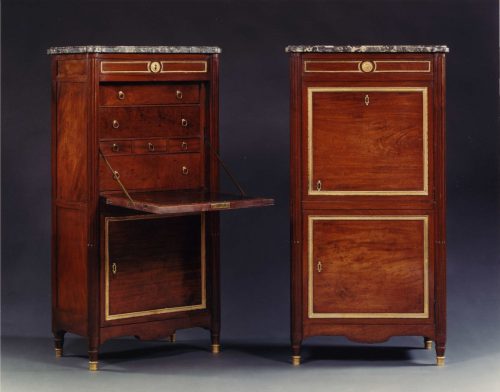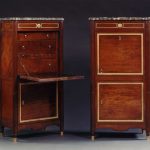9260 A RARE PAIR OF MAHOGANY AND GILT-BRONZE MOUNTED SECRETAIRE ABBATANTS BY JOSEPH CANABAS ONE WITH FALSE FACADE FITTED WITHIN AS A SAFE French. Last Quarter of the 18th Century. Measurements: Height: 52″ (132.5 cm) Width: 26 3/4″ (68 cm) Depth: 15 1/2″ (39cm)

Research
Of mahogany and gilt-bronze mounts. Each with a rectangular marble top with molded upper edge and bosses to the corner above a paneled frieze centered by a molded gilt roundel with cable molding to the edge flanked by panels edged with gilt bead and reel molding, the frieze above two rectangular panels with molded gilt edging and bead and reel molding, the front flanked by two circular tapering fluted and stop fluted uprights, the sides with plain panels, the whole raised on four circular tapering legs terminating in gilt caps. The one with the frieze opening as a single drawer, the upper panel opening as a fall front with inset leather top to an interior set with drawers with ring handles, the lower section opening as a door to a plain interior, the other comprising a safe, with the front opening as a single door to an interior shelved in the upper section and with a compartment below secured by a steel clamp concealing an escutcheon. Gilding refreshed in places. One top possibly not original, but very old.
Marks:
Stamped to the rear:
J CANABAS
Provenance:
Parisian Collection
Beaussant Lefèvre, April 25, 2003, Lot 143
The superb quality and simplicity of these secretaires mark them out as the work of Joseph Canabas (1712 – 1797), the celebrated Parisien ébéniste whose stamp they bear. Canabas was able to work in more than one mode, including Le Style Anglaise and Le Gôut Grec, from which the restrained classical lines of the present cabinets draw their inspiration. Producing pieces which presaged the austerity of design of the Directoire period, his output can sometimes be compared to that of the other great late-Louis XVI ébénistes Adam Weisweiler (1744 – 1820) and Guillaume Benneman (d.1811).
A secretaire attributed to Weisweiler formerly in the collection at Castle Howard, Yorkshire, shares many of the characteristics which make the present secretaires so distinctive. Both eschew superfluous ornament, and rely for effect on the contrast of finely detailed ormolu bands with highly figured mahogany.1 Similarly a pair of commodes by Weisweiler illustrated in Maurice Segora’s monograph demonstrates the French preference for this austere yet richly executed neoclassicism.2 A commode executed in 1787 by Benneman, ébéniste to the French crown between 1786 and 1792, is also composed of hinged panels of mahogany edges with fine gilt bronze molding.3
The geometric simplicity of the present cabinets reveals Canabas to have been one of the pioneers of a radical aesthetic which came to prominence in France during the revolutionary era of the 1790s. This style, which was encapsulated in the designs of avant-garde architects such as Claude-Nicholas Ledoux (1736 – 1806) and Etienne-Louis Boulée (1728-99), offered a pared down classicism which anticipated the sparse minimalism of twentieth-century design.
Boulée wrote of the need to eradicate unnecessary decoration, which he termed “sterile riches”, in pursuit of an austerity that would lead to the “poetry of architecture”.4 Such sentiments could just as well have served as a manifesto for Canabas whose preoccupation with materials and innovation in design set him apart from many of his contemporaries and imbued his work with the same sense of radicalism as Boulée’s.
Canabas was renown for exceptional quality of his ébénisterie. Working, with very few exceptions, in mahogany, he used wood of the highest quality, grain and colour, the results of which can be seen clearly in the present secretaires. Unlike many other ébénistes, Canabas focused his work almost exclusively on the production of small, imaginatively designed items of furniture. The incorporation of a safe behind a false secretaire facade strongly indicates they were a bespoke special commission.
Canabas was born Joseph Gengenbach, the son of a German cabinet maker from the Alsace. He adopted the pseudonym Canabas, which he used to sign his work after moving to Paris. His talent was recognized early on in his career, and before his investiture as a master cabinet maker in 1766 he worked in the rue de Charonne for such notable ébénistes, as Jean-François Œben and Pierre Migeon. Once established at his large workshop in the rue du Fauboug Saint-Antoine, he supplied the exclusive marchands Bennemain le June and the Presel brothers, as well as a range of private clients attracted by his distinctive and beautifully worked pieces.5
Canabas takes his places alongside the great Parisian cabinet makers of the Louis XVI period who were of German origin. Weisweiler, Benneman, Roentgen and Carlin, as well as Canabas, were all based around the Faubourg Saint-Antoine6 and it is from this circle of makers that the finest French furniture of the final years of the ancien regime emerged.
Footnotes:
1. Carlton Hobbs, Catalogue Number Four, London, 1993, item 19.
2. M. Segoura and P. Lemonnier, Weisweiler, Paris, 1983, p27 & p115.
3. Alexandre Pradère, French Furniture Makers: the Art of the Ébéniste from Louis XVI to the Revolution, London, 1989, p407.
4. Visionary Architects, Houston, University of St. Thomas, 1968, p. 14, 72.
5. P. Kjellberg, Le Mobilier Français du XVIIIe Siècle, Paris, Les Édition de l’Amateur, 1989, p. 144-6.
6. S. Eriksen, Early Neo-Classicism in France, London, 1974, p132.

Comments are closed.